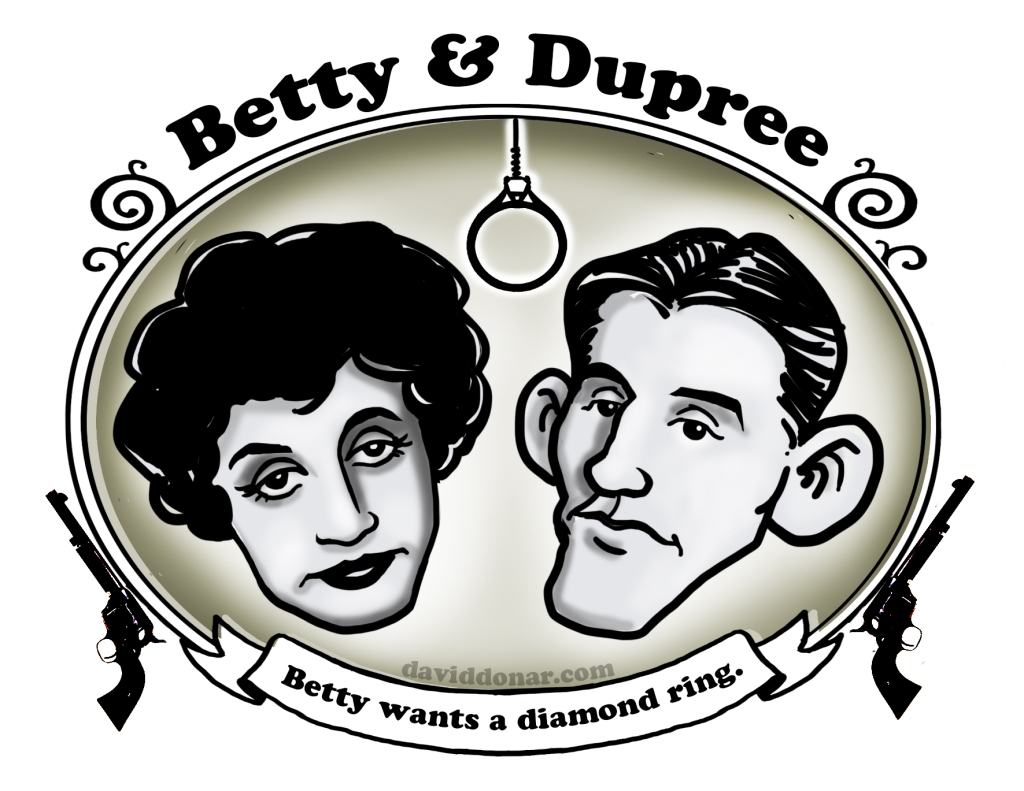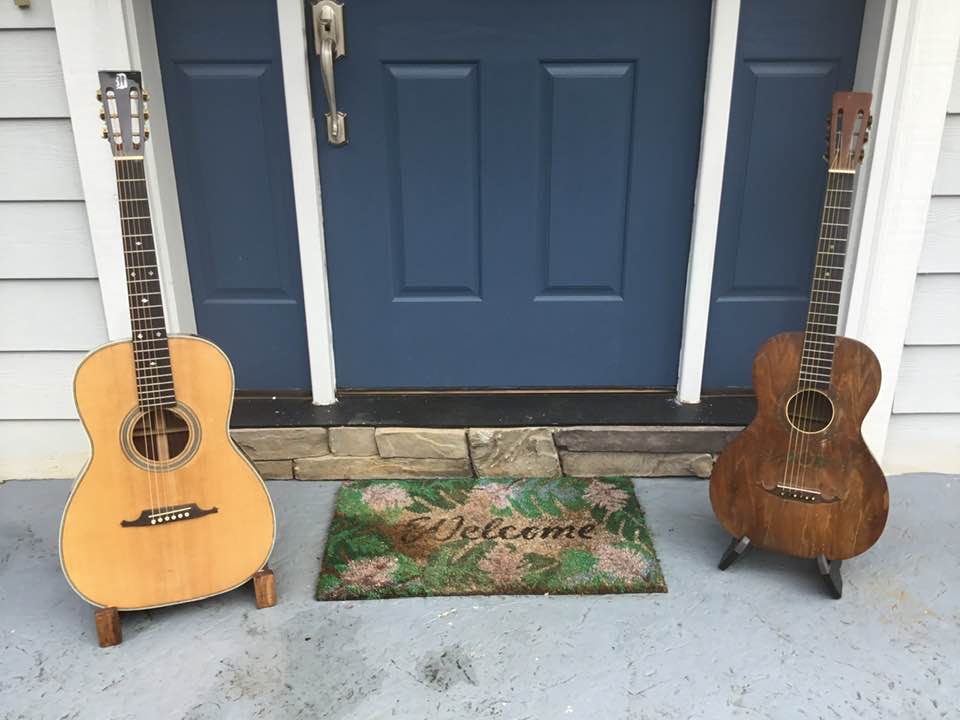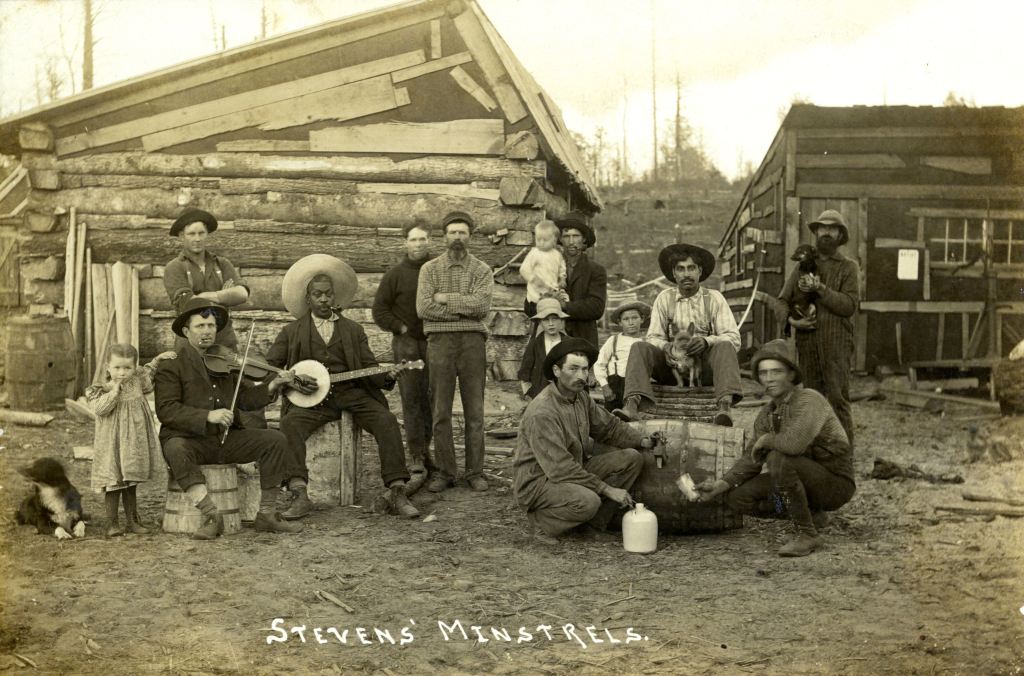I am a folklorist, cartoonist and a professor of Art with an interest in old time music and folk tales. I believe that story telling is one of the foundations of what it is to be human. Stories can be ethnic, cultural, spiritual, emotional, political, humorous, regional, personal, true and/or false. Narrative can be expressed through art, literature, music, film, theater, religious and secular means. What I love about story is how it can change and evolve over time by various medium and person. The very nature of folk tales or folk tunes for that matter is to be expressed orally within a live setting. Stories are handed down and with each performance it changes to reflect the audience and or teller. Folksongs are not meant to be frozen but to be played and interpreted in many different ways. Ironically, by recording or publishing a folksong or tale, you create a situation where it can become dogmatic or “set in stone”. Probably why, I like the web format as each story or song that I am interested in can be changed or grouped into a series of evolving work.
Folktales, Legends and Myths
I will try not to get into formal syntax or definitions, but it’s good to have a starting point and being an Academic, I cannot help myself. So what is a Folk Tale and how is it different from a Legend, Fable, Allegory, Myth? There are definitely similarities and common values, but it’s good to understand how they differ and how one can use these genres to guide in a deeper meaning.
Ballads, A popular narrative song passed down orally. In the English tradition, it usually follows a form of rhymed (abcb) quatrains alternating four-stress and three-stress lines. Folk (or traditional) ballads are anonymous and recount tragic, comic, or heroic stories with emphasis on a central dramatic event; examples include “Barbara Allen” and “John Henry.” Beginning in the Renaissance, poets have adapted the conventions of the folk ballad for their own original compositions. Examples of this “literary” ballad form include John Keats’s “La Belle Dame sans Merci,”Thomas Hardy’s “During Wind and Rain,” and Edgar Allan Poe’s “Annabel Lee.” Browse more ballads. https://www.poetryfoundation.org/learn/glossary-terms/ballad
Legend, by the very nature of the word, is to write down or recording an event or story, usually based on something that actually happened. Legend refers to Ledger, something you write in. So the Legend of John Henry or Paul Bunyan could be legendary as it was written down at one point and then rewritten through various regions and cultures.
Myth or Mythos, is similar to a Legend in that it has taken artistic license of person and elevated them into a supernatural status. Paul Bunyan and John Henry had supernatural strength and could be colossal in size and stature.
Folk Tales or a Folk Hero is an oral tradition and so before there was literacy and books, It was the eyes, ears and mouth that were the primary mode of story.
Allegories are stories that have morals or deeper meaning and often can be found in religious and philosophical teachings. My personal favorite Allegory is the Ring of Gyges.
Fables are like allegories but tend to use animals in place of humans to help express ideas and morals without alienating a certain group or person.
This site is not a definitive or comprehensive resource for all that is folk tales or songs, but I would like to share with you my progression into performing and interpreting folk tales through art, song and music. My work continues to evolve through practice and deeper learning of the history and by exploring of the story and songs of others, I hope to constantly update and refine this site.
I want to acknowledge that this would not be possible without the immense cultural contributions of African Americans past and present. This is the inspiration of my work and it is important to be conscientious of cultural appropriations and the pitfalls that can come with it. American Folk tales are diverse and has been influenced by all the various groups that have come here, but it is distinctly through the contributions of the African Americans and the challenges and context of their struggles that shape this path. What I hope is through the sharing of story, song and art will inspire us to become aware of such challenges and have a better understanding of what makes us all human and how we can unite to inspire future generations to create a better place for all.
Rails, Rascals and Revenge
Songs about the railroad are immense and I suppose it’s the rhythmic sound of the track or that traveling troubadours found a new and exciting way to travel. During the time of the rail roads, people could travel much easier and faster and with the guitar coming into mass production around the same time period, it created a perfect platform for new songs.
HEROS
Heros are often the subject matter of myths, legends and folktales.
John Henry, the Myth, Legend and Folk Hero

https://www.redbubble.com/people/donar/shop
John Henry has been the subject of many songs and stories and there is strong evidence that it is based on a real person. The Rails needed a lot of workers and often hard labor was done by ethnic minorities, immigrants, and prisoners. John Henry is most recognized as an African American Man who worked on driving spikes into the rails or building the rail tunnels in West Virginia during the late 1800’s. This work was no doubt hard and dangerous as many died or were seriously injured. Labor laws or protections hardly existed and many had no choice or options when it came with such employment. The Myth or Legend of John Henry is about a man overcame the machine but perished as a result. I believe that John Henry was a messianic figure in that he sacrificed himself for the benefit of the common laborer. The song of John Henry is very diverse as the verses evolved and there are many different versions. In one particular verse, he born as a fully grown man and has supernatural strength and ability from birth. Some verses can get very lewd or sexual as with any story or moment, the teller will take artistic license or liberties and create sensationalism to evoke a response from their audience.
http://www.wvculture.org/history/africanamericans/henryjohn05.html
https://www.loc.gov/collections/john-and-ruby-lomax/about-this-collection/
Courtesy of Johnstown Heritage Assoc.
https://www.jaha.org/edu/discovery_center/work/john_henry/index.
(Also on recording is folklorist Herbert Halpert.) Recorded at Federal Music Project Office, Jacksonville, Florida on June 18, 1939.
John Henry like any other hero or subject matter can take on a lot of other ideas or meanings. I personally gravitate to the sacrifice that he makes and that he gives hope to a marginalized group. In a way, I like to think that he is the first American Super Hero.
Interpretations
John Henry has inspired many variations and new songs altogether. One particular song is by Mississippi John Hurt’s “Spike Driver Blues”. I like to think it’s the sequel or John Henry’s fellow worker who decided to walk away from the job. Perhaps the antithesis of John Henry, someone who had more common sense and felt there was a better way. The silver hammer was colored in red but rang in gold. A powerful metaphor that uses color to help drive the message.
MISSISSIPPI JOHN HURT: World-renowned master of the acoustic guitar John Hurt, an important figure in the 1960s folk blues revival, spent most of his life doing farm work around Avalon in Carroll County and performing for parties and local gatherings. Hurt (1893-1966) only began to earn a living from music after he left Mississippi in 1963 to play at folk festivals, colleges, and coffeehouses. His first recordings, 78 rpm discs released in 1928-29, are regarded as classics of the blues genre. http://www.msbluestrail.org/blues-trail-markers/mississippi-john-hurt

CASEY JONES

Casey Jones was a railroad engineer known for his speed who died in 1900, when he collided with another train. Shortly after Casey Jone’s death, Wallace Saunders, an engine wiper who worked for the I.E., wrote “The Ballad of Casey Jones”, a tribute to Jones, who Saunders greatly admired. https://www.biography.com/personality/casey-jones
HOBOS – Old Bill Jones

Inspired by Charlie Poole‘s Milwaukee Blue, I adapted the song into “Detroit Blues”. The song shares many similar phrases from Casey Jones, and I have no doubt Charlie Poole begged, borrowed and stole from many others as it is the custom of folk tunes to be shared, changed and reinterpreted. Riding the rails in particular was a very dangerous way to hang from the bottom of a train car to avoid detection.
Glossary: http://www.hobonickels.org/terms.htm
Bum – A non-migratory non-worker. A worthless or dissolute loafer who would rather beg than work for goods or services. Lowest in the “hobo hierarchy.” It is a term of many meanings, but in its most authoritative uses it refers to the lowest of vagrants. From the German: Bummler, meaning to loaf.
Tramp – Migrating non-working vagrants. A grade higher than scenery bums, dingoes. From the middle German: Trampen.
Hobo – A migratory (itinerant) usually unskilled worker. Most respected in the “hobo hierarchy.” The hobo is “independent.” Unlike tramps or bums, the hoboes are usually very resourceful, self reliant and appreciative people. They avoid long term work commitments, preferring to be free to follow the call of the open road when it comes. From “Hoe Boy” after the itinerant 19th century farm laborers, who trainhopped with their belongings in a bundle tied to a hoe.
Cannonball – a fast train
Catch the Westbound – to die
Ramble – To ramble (a Middle English for “roam”) means to wander for pleasure, without a fixed destination.
Ridin’ the rods – An old-time hobo practice, now virtually obsolete. The hobo would place a board across truss rods under a car and ride on it. This was very dangerous even in pleasant weather, and the possibility was ever present that you might doze, get careless, become too cramped, or lose your nerve-and roll under the wheels.
Town clown – The village constable. The town policeman.
Tramp (verb) – To ride freight trains. I have been tramping for years.
RASCALS
Legends and Folktales with villains or outlaws are my favorite. Conflict always seems to be the best form of story and when your main character is severely conflicted, it makes it all the more compelling.
Stagger Lee, aka Stack O Lee

Stagger Lee is based on a real event and person, Shelton Lee.https://missourilife.com/real-story-behind-bad-man-stagger-lee/. Though the events tend to be embellished or enhanced for creative purposes. This character has been the basis for tons of songs and variations. You know a song is a classic when the Grateful Dead do a version. I’d like to think the great Jim Croce’s “Bad Leroy Brown” had to be influenced by this archetype. My favorite version is by Mississippi John Hurt, but I decided to go with a Banjo in Sawtooth Tuning to give it a sort of an Appalachian feel. This song is relevant today as we see the challenges with law enforcement and the African American communities that they serve. Drugs, gangs and crime flourished in underserved communities which bred a lot of resentment and fear of the authorities. In these earlier folk songs, the villain or outlaw would often be elevated into folk hero status as they rebelled against the system. Shelton Lee never did go to the gallows in real life, but died of tuberculosis while in prison. During our current pandemic which has disproportionately affected minority populations, so too did tuberculosis back in the early 20th century.
RAIL ROAD BILL
The legend of Railroad Bill arose in the winter of 1895, along the Louisville and Nashville (L&N) Railroad line in southern Alabama. Based loosely on the exploits of an African American outlaw known as “Railroad Bill,” tales of his brief but action-filled career on the wrong side of the law have been preserved in song , fiction, and theater. He has been variously portrayed as a “Robin Hood” character, a murderous criminal, a shape shifter, and a nameless victim of the Jim Crow South. http://www.encyclopediaofalabama.org/article/h-1258
MURDER BALLADS
Are as old as humankind. Love, Jealousy, Deception, Betrayal, Crime and Punishment…all things that tend to engage us at our very core.
Murder Ballads in the 1900’s acted like a news report or story that helped informed people across America about events happening in a particular place. Of course names and events were changed or embellished for dramatic effect and various endings and subplots with each new version.
Betty and Dupree
Betty and Dupree based on true events from Atlanta in 1921 from the book…Hanging the Peachtree Bandit by Tom Hughes. The song takes liberties in that Betty is a conspirator in the crime or at the very least partially to blame. This probably stems from the Old Testament’s Adam and Eve story. The song has evolved and through the hands of African American musicians, it has taken on greater depths. I connect with Brownie Mcghee’s version as well as Blind Willie Walker’s.


Frankie and Johnny

Turn of the 19c Frankie Baker killed Albert Britt in St. Louis. Frankie eventually was acquitted of the murder by claiming self defense. Bill Dooley wrote a tune shortly afterwards and this started a long line of songs and interpretations. One particular aspect of this murder ballad is that the woman is the main culprit. Traditionally murder ballads usually have the female as the victim and tended to be misogynistic in nature. With Frankie, we have a story that involves urban conflicts and delves into prostitution, alcohol, drugs, and crime. Similar to Stagger Lee in that these events occur in St. Louis around the same time. Frankie and Albert was eventually changed to Frankie and Johnnie. The song has many different endings even with her ending up in the electric chair. The real life Frankie ended up in Oregon and died in a mental hospital.
I particularly like Jimmie Rodgers version.
From NPR…Interview with Cecil Brown and his essay published in The Rose and the Briar: Death, Love and Liberty in the American Ballad.
https://www.npr.org/player/embed/4185374/4185375
An interesting connection to Stagger Lee…http://stories.kera.org/staggerlee/myth-in-the-music/
I do another version with an Accordion, which definitely gives it a different vibe.
Instruments

Finally arranging these folk tunes can be fun and quite challenging. Guitar being the primary mode of folk songs in that the instrument is very versatile and tends to compliment the human voice. In some ways we have taken the guitar for granted and believing that it was around for a long time. Matter of fact, guitars were not all that common in the 1800’s and even up to the 1930’s it was hard to come by one. Sears Roebuck’s catalog and mail delivery was the main force in letting the common folk acquire such an instrument. Most guitars prior to 1930’s were primarily “parlor” guitars, meaning they were marketed for middle class women to play classical or sheet music in the Parlor. The fiddle and banjo were far more common and played as folk instruments prior to WWII.

The Banjo has long been associated with Blue Grass and for good reason, but Blue Grass is a modern invention created in the post world war 2 era. Old Time or Old Tyme music is much deeper and ingrained in rural American folk lore. Even deeper and older is the origins of the banjo going back into Africa with the gourd or hallowed out vessel to which a string or gut is stretched upon a neck or stick. Minstrel Shows have long been stigmatized as deeply racial and offensive, but the heritage and music that came from this period is complex and has value if taken in context. I believe artists like Rhiannon Giddens is shedding more light and bringing this music into a new realm. I believe that the Banjo is truly an American Instrument and encompasses a wide scope of the folklore tradition and culture.

Finally here are a few resources to help further your understanding. By no means is this comprehensive and I look forward to updating and revising as I continue my pursuit of this wonderful tradition and practice. Links are throughout the Blog Page.
Blues Fell This Morning, Meaning in the Blues, by Paul Oliver. Cambridge University Press
You Can’t Win, by Jack Black. AK Press
A Six String History of America by Jay M. Pilzer. American History Press
Mississippi John Hurt, His Life, His Times, His Blues by Philip R. Ratcliffe. University Press of Mississippi





